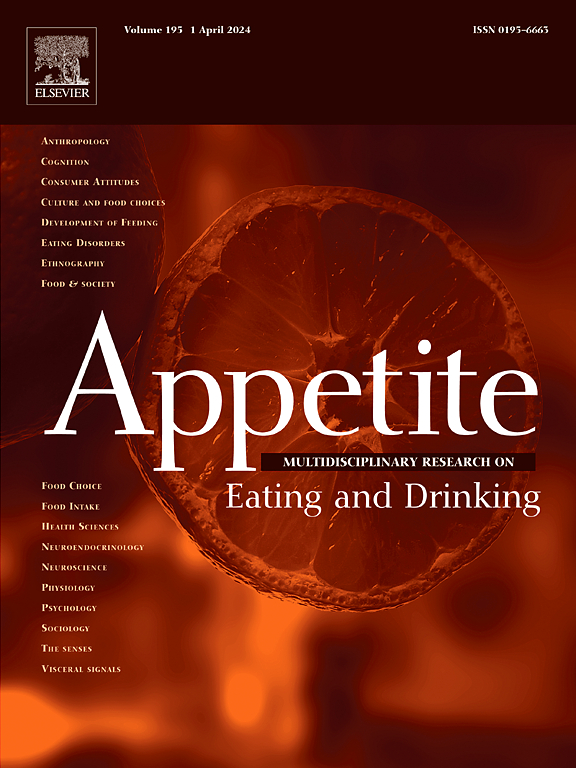从商店到家里:父母对婴儿零食选择的见解
IF 3.8
2区 医学
Q1 BEHAVIORAL SCIENCES
引用次数: 0
摘要
在婴儿时期建立的饮食习惯在塑造神经和身体发育以及未来的食物偏好方面发挥着重要作用,强调了在此期间仔细选择食物的重要性。这项研究调查了在越来越多的人担心婴儿的营养成分的情况下,驱使父母选择商业零食的原因。对瑞士22名6-18个月的婴幼儿父母进行了半结构化访谈。父母们还被要求展示他们家里提供给婴幼儿的所有商业零食。我们的访谈显示,一般来说,方便是选择商业婴儿、儿童和成人零食的首要标准,健康考虑是次要的。尽管如此,一些商业婴儿零食被认为提供了额外的健康益处。商业婴儿零食的安全性,特别是在质地和成分方面,成为影响其购买的关键因素,尽管成本较高。研究分析了151张商业零食的照片(N = 101种不同的零食产品),这些照片是在参与者家中为他们的婴儿和学步儿童准备的,结合采访的见解,揭示了尽管一些父母承认婴儿专用零食的好处,但他们仍然经常为他们的婴儿和学步儿童选择针对年龄较大的儿童或成人的商业零食。选择的商业零食包括59%的婴儿,17%的儿童,25%的成人零食。这种行为反映了父母选择标准的权衡,受到实际因素的影响,例如成本考虑和随着孩子长大,婴儿专用零食变得不那么必要的观念。我们的研究结果表明,食品行业、政策制定者和医疗保健专业人员应该共同努力,支持父母为婴幼儿选择适合年龄的零食。关键行动可能包括使婴儿零食更便宜,提高对安全益处的认识,并确保清晰、一致的标签。本文章由计算机程序翻译,如有差异,请以英文原文为准。
From store to home: Insights into parental baby snack choices
Feeding habits established during infancy play a significant role in shaping neural and physical development as well as future food preferences, emphasizing the importance of careful food selection during this time. This study examines the reasons driving parents' choices of commercial snacks for their infants amid growing concerns over their nutritional content. Semi-structured interviews were conducted with 22 parents of infants and toddlers aged 6–18 months in Switzerland. Parents were also asked to show all the commercial snacks available at their homes that they provide to their infants and toddlers. Our interviews revealed that convenience was the primary criterion for selecting commercial baby, child, and adult snacks in general, with health considerations being of secondary importance. Nonetheless, some commercial baby snacks were perceived to provide additional health benefits. The safety of commercial baby snacks, particularly in terms of texture and ingredients, emerged as a key factor influencing their purchase, despite the higher costs. The analysis of 151 photographs of commercial snacks (N = 101 different snack products) present in participants’ homes and intended for their infants and toddlers, combined with insights from the interviews, revealed that although several parents acknowledged the benefits of baby-specific snacks, they still frequently chose commercial snacks marketed for older children or adults for their infants and toddlers. Commercial snacks selected included 59 % infant, 17 % child, 25 % adult snacks. This behavior reflected a trade-off in parental selection criteria, influenced by practical factors, such as cost considerations and the perception that baby-specific snacks become less necessary as children grow. Our findings indicate that the food industry, policymakers, and healthcare professionals should work together to support parents in choosing age-appropriate snacks for infants and toddlers. Key actions may include making baby snacks more affordable, raising awareness of safety benefits, and ensuring clear, consistent labelling.
求助全文
通过发布文献求助,成功后即可免费获取论文全文。
去求助
来源期刊

Appetite
医学-行为科学
CiteScore
9.10
自引率
11.10%
发文量
566
审稿时长
13.4 weeks
期刊介绍:
Appetite is an international research journal specializing in cultural, social, psychological, sensory and physiological influences on the selection and intake of foods and drinks. It covers normal and disordered eating and drinking and welcomes studies of both human and non-human animal behaviour toward food. Appetite publishes research reports, reviews and commentaries. Thematic special issues appear regularly. From time to time the journal carries abstracts from professional meetings. Submissions to Appetite are expected to be based primarily on observations directly related to the selection and intake of foods and drinks; papers that are primarily focused on topics such as nutrition or obesity will not be considered unless they specifically make a novel scientific contribution to the understanding of appetite in line with the journal's aims and scope.
 求助内容:
求助内容: 应助结果提醒方式:
应助结果提醒方式:


